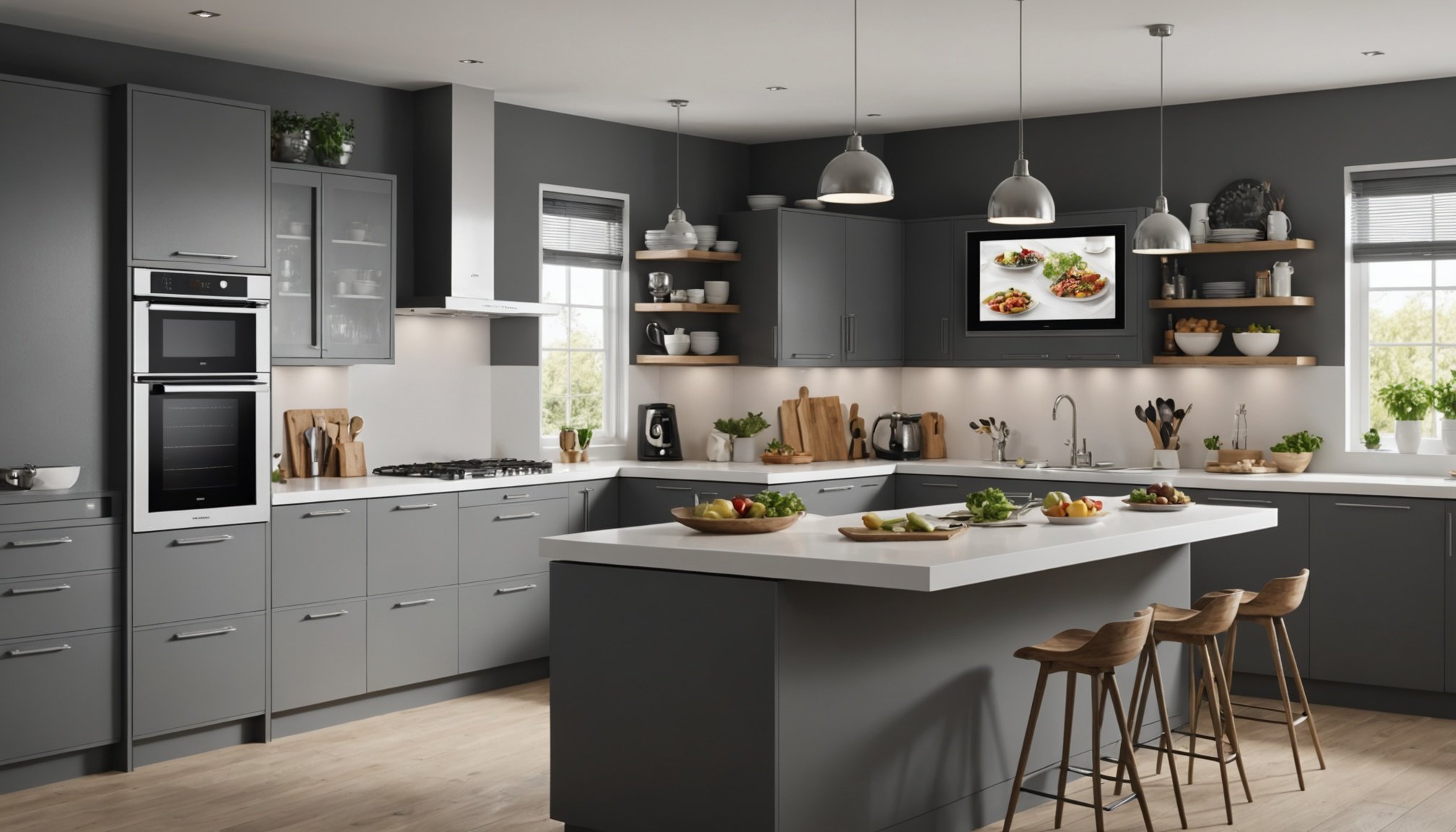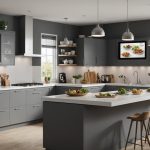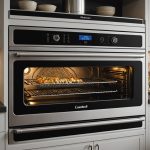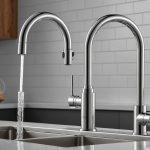Ideal Positions for Kitchen TVs or Screens: Minimize Distractions While Cooking!
When it comes to designing your kitchen, one of the modern conveniences that many homeowners want to incorporate is a TV or screen. However, placing a TV in the kitchen can be a bit tricky, as you need to balance the desire for entertainment with the need to minimize distractions while cooking. Here’s a comprehensive guide to help you find the ideal position for your kitchen TV or screen.
Understanding Your Kitchen Layout
Before deciding where to place your TV, it’s crucial to understand the layout of your kitchen. An open kitchen concept, for instance, blends seamlessly with the living and dining areas, making the placement of a TV more versatile but also more challenging.
In parallel : Effective Strategies for Creating a Low-Height Snack Drawer to Curb Overeating in Kids
Defining Zones Within the Space
In an open kitchen, defining zones is essential to maintain functionality and a sense of separation between different areas. You can use furniture, rugs, or different types of flooring to demarcate these zones. For example, a dining table can serve as a natural divider between the kitchen and the living room. Similarly, a rug under the dining table can visually separate the living space from the kitchen.
Choosing the Right Location
The location of your TV or screen in the kitchen is critical to ensure it enhances your cooking experience without becoming a distraction.
Have you seen this : Maximize Freshness and Minimize Waste: The Ultimate Guide to Bread Storage Solutions for Compact Kitchens
Above the Kitchen Island
Placing a TV above a kitchen island can be a great idea, especially if you have a large island that serves as a central hub in your kitchen. This position allows you to watch your favorite shows while preparing meals, and it can also serve as a focal point for the room.
Pros:
- Central location, easy to view from multiple angles
- Can be mounted to save counter space
- Adds a modern touch to the kitchen design
Cons:
- May obstruct the view if the island is used for seating
- Requires careful mounting to avoid visual clutter
On a Wall Opposite the Cooking Area
Mounting the TV on a wall opposite the cooking area is another popular option. This placement ensures that you can watch TV while cooking without it being directly in your line of sight, which can be distracting.
Pros:
- Keeps the TV out of the direct cooking area
- Allows for easy viewing while preparing meals
- Can be mounted at a comfortable viewing height
Cons:
- May require additional wiring or cable management
- Could be affected by glare from kitchen lighting
In a Corner or Nook
For smaller kitchens, placing the TV in a corner or a nook can be an excellent way to utilize dead space. This position can also help in creating a cozy viewing area within the kitchen.
Pros:
- Utilizes often-wasted corner space
- Can create a cozy viewing nook
- Keeps the TV out of the main cooking area
Cons:
- Viewing angle might be limited
- May not be suitable for larger TVs
Considering Lighting and Design
Lighting and design elements are crucial when placing a TV in the kitchen to ensure it integrates seamlessly and does not become a distraction.
Lighting Considerations
Proper lighting is essential to enhance the viewing experience and reduce eye strain. Here are some tips:
- Natural Light: Ensure that the TV is not placed in a way that it is directly exposed to harsh natural light, which can cause glare. Large windows or glass doors can be beneficial, but consider using sheer curtains to filter the light.
- Artificial Lighting: Use under-cabinet or recessed lighting to illuminate the cooking areas without cluttering the room with bulky lighting fixtures. This can also help in reducing glare on the TV screen.
Design Integration
The TV should blend in with the overall kitchen design to avoid visual clutter.
- Materials and Colors: Choose materials and colors for your TV mount and surrounding decor that reflect the look of the rest of your home. Neutral colors like white, beige, or light grey can help the TV blend in seamlessly.
- Consistent Flooring: Ensure that the flooring in the kitchen is consistent with the rest of the open living areas to create a smooth transition between zones.
Practical Tips for Installation
Here are some practical tips to consider when installing a TV in your kitchen:
Mounting Options
- Wall Mount: A wall mount is a great way to save space and keep the TV out of the way. Make sure to choose a mount that allows for adjustable viewing angles.
- Ceiling Mount: For a more modern look, consider a ceiling mount, especially if you have a high ceiling. This can provide a unique viewing experience and keep the TV completely out of the way.
Cable Management
- Hide Cables: Use cable management solutions to hide wires and cables, keeping the kitchen area clutter-free and visually appealing.
- Power Outlets: Ensure there are enough power outlets nearby to plug in the TV and any other devices you might need.
Real-Life Examples and Anecdotes
Here are a few real-life examples and anecdotes that highlight the importance of careful TV placement in the kitchen:
A Family's Experience
"I wanted to make our kitchen a hub for family activity, so I installed a TV above our kitchen island. It's been a game-changer for family dinners and cooking sessions. However, I had to ensure it was mounted high enough to avoid obstructing the view and to prevent it from being a distraction while cooking," says Sarah, a homeowner who recently renovated her kitchen.
A Designer's Insight
"When designing a kitchen with a TV, it's crucial to consider the flow of the room. I once designed a kitchen where the TV was placed in a corner, creating a cozy nook that didn't interfere with the cooking area. The clients loved it because it added an entertainment element without compromising the functionality of the kitchen," explains Jane, an interior designer.
Table: Comparing Different TV Placement Options
Here is a comparative table to help you decide on the best placement option for your kitchen TV:
| Location | Pros | Cons | Suitability |
|---|---|---|---|
| Above Kitchen Island | Central location, easy to view, modern touch | Obstructs view if island is used for seating, requires careful mounting | Large kitchens, open kitchen concepts |
| On a Wall Opposite Cooking Area | Keeps TV out of direct cooking area, easy viewing while cooking | Requires additional wiring, glare from kitchen lighting | Most kitchen layouts, especially those with ample wall space |
| In a Corner or Nook | Utilizes dead space, creates a cozy viewing area | Limited viewing angle, not suitable for large TVs | Small kitchens, kitchens with unused corners |
Placing a TV or screen in your kitchen can be a wonderful way to enhance your cooking experience, but it requires careful consideration to ensure it does not become a distraction. By understanding your kitchen layout, choosing the right location, considering lighting and design elements, and following practical installation tips, you can create a harmonious and functional kitchen space that meets all your needs.
Whether you're looking to create a central hub for family activity or a cozy viewing nook, the key is to make sure the TV integrates seamlessly into your kitchen design. With the right placement, you can enjoy your favorite shows while cooking, making the kitchen a more enjoyable and multifunctional space in your home.











